I will note right away that I do not set myself the goal of making a complete guide on the selection of bass guitar strings. I’m just sharing a set of thoughts that I’ve had since 2001 when I first started playing bass. I’m still experimenting with strings, it’s interesting to me. If new observations appear, I will definitely add them to the article. So, what strings to choose for bass?
I will arrange my thoughts in the form of a set of theses that seem important and useful to me. I’ll only talk about round-wound strings. I play fretted bass. I play mostly with my fingers, not with a pick.
Why different musicians will like different strings
Tastes are different. Many factors influence this, including the music that has shaped the bassist, which he listens to more often, which he plays. I grew up on prog metal, art-rock music, then some jazz, pop music was added, but I rarely listen to, for example, pop punk or indie pop. A set of musical vocabulary forms and calibrates an understanding of what the correct sound should be. Sometimes you turn on a bass guitar video, and there is some kind of horror with the sound, and the bassist says: Awesome. We have different tastes. Sometimes the reason is something else, which is what the next paragraph is about.
- Sometimes an inexperienced musician hears not what actually sounds, but what sounds in his head. In order not to fall into such a trap, it is necessary to record how you play concerts, rehearse with musicians and independently.
- Not only do different strings sound different, but the same strings sound different on different instruments. Since 2010 I’ve been playing mostly Warwick Thumb basses, so keep in mind that not all of my observations will hold true for other instruments.
- In different hands, the same set of strings, bass and other equipment sounds
differently. Different plucking technique, position on the fretboard can give a greater difference in sound than different strings. - Strings are not only about sound, but also about playing comfort. I find it more comfortable to play with a stronger string tension. So in drop C I like Ernie Ball Cobalt more, and for DR Fat-Beams I increase the action to increase the tension. Different strings have different tactile sensations.
- The best way to understand the sound is to take strings, put them on your bass, play them, and record them. But my theses can hopefully help, too, by narrowing down the range of string models to be tested and giving direction to your search.
I’ll write a little about the bass sound. It matters in context. It can often happen that in a mix, in a song, he likes it, but separately not so much. It’s worse when it’s the other way around. It is important to keep this fact in mind and listen to the sound in the conditions in which you are going to use it.
How often should you change your bass strings
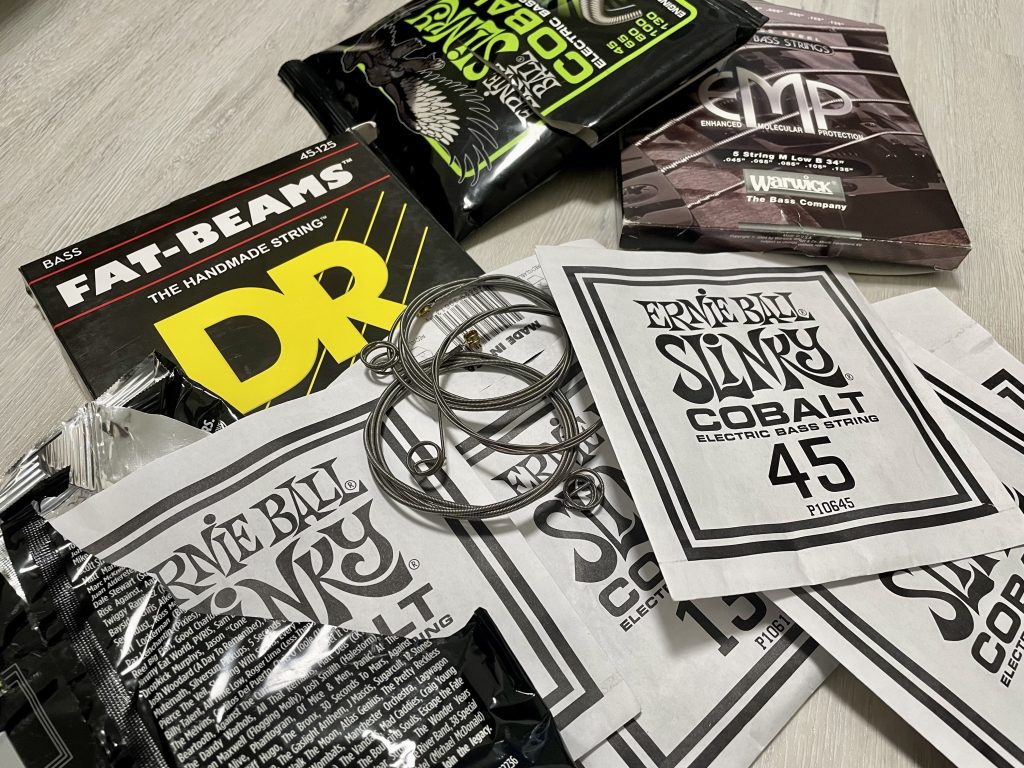
Usually you put a new set on the bass, play it, everything sounds cool. And after a while, the following happens. You start tweaking the equalizer to improve the sound. Something is wrong with the sound. This is the moment when, ideally, you need to change the strings. It can happen after a week or after a month or two for different strings and different playing intensities. If you watch how famous musicians record songs, you can see that some of them change strings before recording each new song. Maybe it’s too much, but before recording a new album, the strings definitely need to be changed. The strings begin to die on the thickest, B string. First of all, it is in them that the loss of overtones makes the sound boring, meager, and not in thin strings. At least that’s my personal observation. A thin string can still ring for a long time when the fifth one is already dead.
Above we talked about the ideal situation. If you do not earn music and do not have the opportunity to change strings often, you can use Ernie Ball Cobalt or strings coated with EMP Warwick, if you are satisfied with their sound. They do not die abruptly, but for a long time they sound quite worthy. But if you play concerts, actively rehearse and record songs, then you should change the strings at least once a month – one and a half, but most likely more often. And the sound engineer will thank you, and the audience will be satisfied.
How to “boil” bass strings
It’s not always possible to buy new strings, either because of the high cost or logistical issues when you’re geographically or politically remote. In this case, there are two solutions, it is either to use longer lived strings: coated strings like EMP Warwick or Ernie Ball Cobalt, which keep a reasonable pretty good sound a little longer. Or pick a very cheap set to afford to change often.
If you don’t like the sound of the first option, then you can try to restore the strings. String wear occurs for two reasons:
• Mechanical Wear. The strings rub against the fret and fatigue deformation accumulates in them. Sometimes it seems that if you let the strings lie and then put them back on the bass, they start to sound better. But this is without rigorous experimentation, at the level of feeling. As a rule, mechanical wear and tear cannot be corrected in domestic conditions.
• Contamination. Dirt accumulates on the coils of the winding: grease, skin particles, etc. You should wash your hands before playing to delay this process longer.
In the second case, you can do the following. Loosen the tension of the string and ‘pop’ it several times. Do this with each string. Sometimes the difference is very noticeable if the strings are not worn out. But this is a quick solution in case you need to finish the last verse of the song and have no time to change the strings.
The basic solution is boiling. But instead, I will name two more effective alternative methods.
The first is to wash the strings in a grease-breaking detergent, Fairy or similar. Beforehand, the strings are rolled up into coils. After the procedure is well washed in running water and dried.
The second way. I consider it the most convenient and effective. We wrap the strings in coils and dip them in 96% alcohol for a while, let them soak in it for half an hour. Rinse and dry.
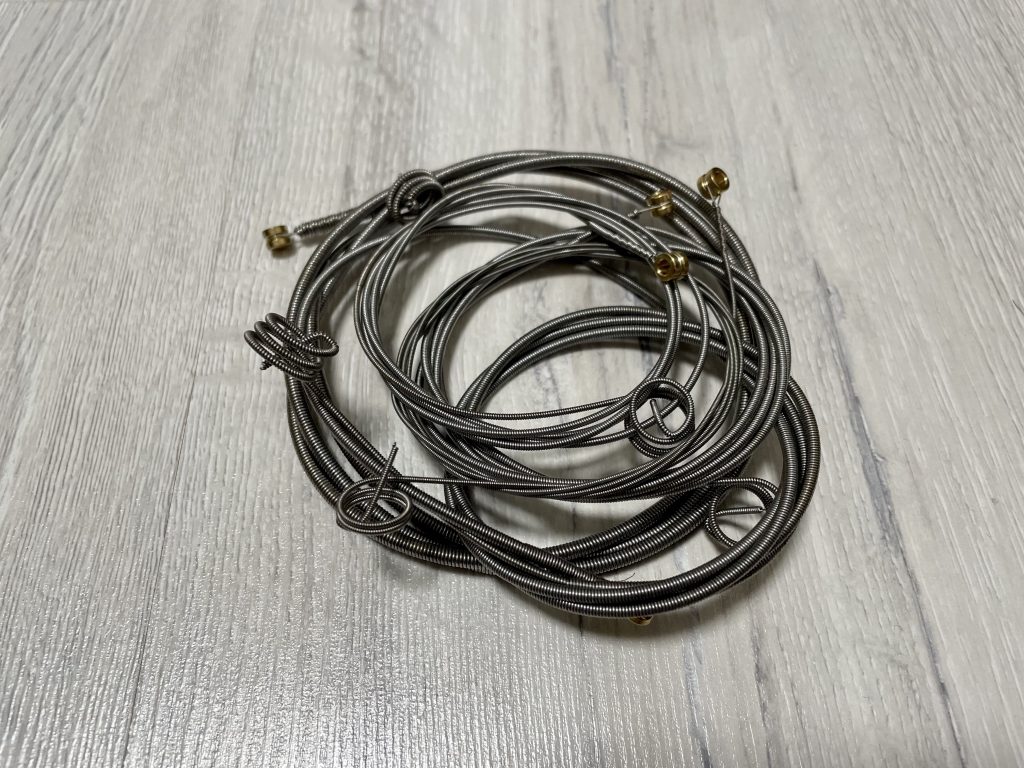
Not all strings can be restored this way. Several times to do the procedure with one set is difficult, because the sound begins to have a strong influence mechanical wear. Also, I could not normally restore Ernie Ball Slinky Cobalt, D’addario ProSteels different sets, Warwick Red label, but very well restored DR Hi-Beams and Fat Beams.
What gauge bass strings for drop C
I like drop C tuning, on 5th bass it’s usually FCGCG or FCGCA where F is the first string. I love strong string tension, but at the same time I achieve it by increasing the action, not the gauge of the strings. I use a medium gauge for both low and standard tunings: 45 – 130 or 45 – 135. If you put thicker strings, they are more boomy on my instrument, and less attack.
Which bass strings to buy is always a debatable issue. I will describe below my observations, which I mark to myself in order to simplify the choice and recall my feelings. These will not be direct quotes from my notes, I will slightly correct them for a better perception by the reader. Remember that this is only my vision based on a certain taste, bass and music that I listen to and play.
My Notes on Specific Bass String Models
Top 1
The first place is shared by three types of strings: DR Hi-Beams 45 – 130 (45 – 125), EMP Warwick Stainless steel 45-135 and D’Addario Pro Steels ESP165-5 45-135.
DR Hi-Beams have the coolest growl in strings number 4 and 5. The growl has a certain softness to it. I like it a lot. One recipe for the sound is as follows. I play aggressively with a strong attack, add in top and bottom frequencies, apply strong compression. The sound recorded with them in a line goes right into the song even without any additional processing. They are smooth and beautiful in appearance (yes, there are different strings :))
There is a nasal sound, but it is beautiful. Many overtones are well read and are not lost in the instrumental pack. In the thin strings the ringing is moderate, closer to the sound of Victor Wooten and Kinga Głyk, with a lot of middle. They recover well with alcohol, after which they sound almost like new for a period of time. Sound good on unplugged bass guitar, both thick and thin strings. Holds tuning well, the fifth string fits comfortably in my bridge.
D’Addario Pro Steels are similar in sound to DR Hi-Beams, are slightly less durable, but cheaper. I tried D’addario ProSteels Reg Light top/med bottom ESP165-5 45-135 and D’addario ProSteels medium gauge ESP160-5 50-135. I like the first ones better. Nick Lombardi makes a very cool sound on these strings https://www.youtube.com/watch?v=JQY9gs0MbqI
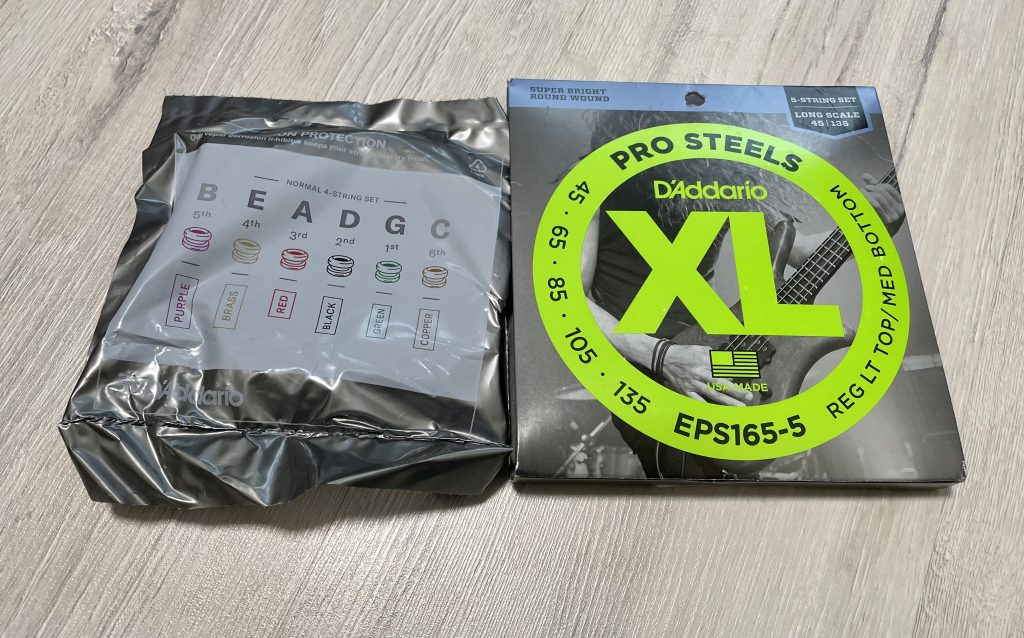
EMP Warwick Stainless steel 45-135 has a great growl, but is darker and more brutal than the Hi-Beams. For the 4th and 5th strings on an unconnected instrument, growl is not heard, it is somewhere lower in frequencies than in DR. Therefore, it may seem that something is wrong. But as soon as you connect the bass to the amplifier, all questions disappear.
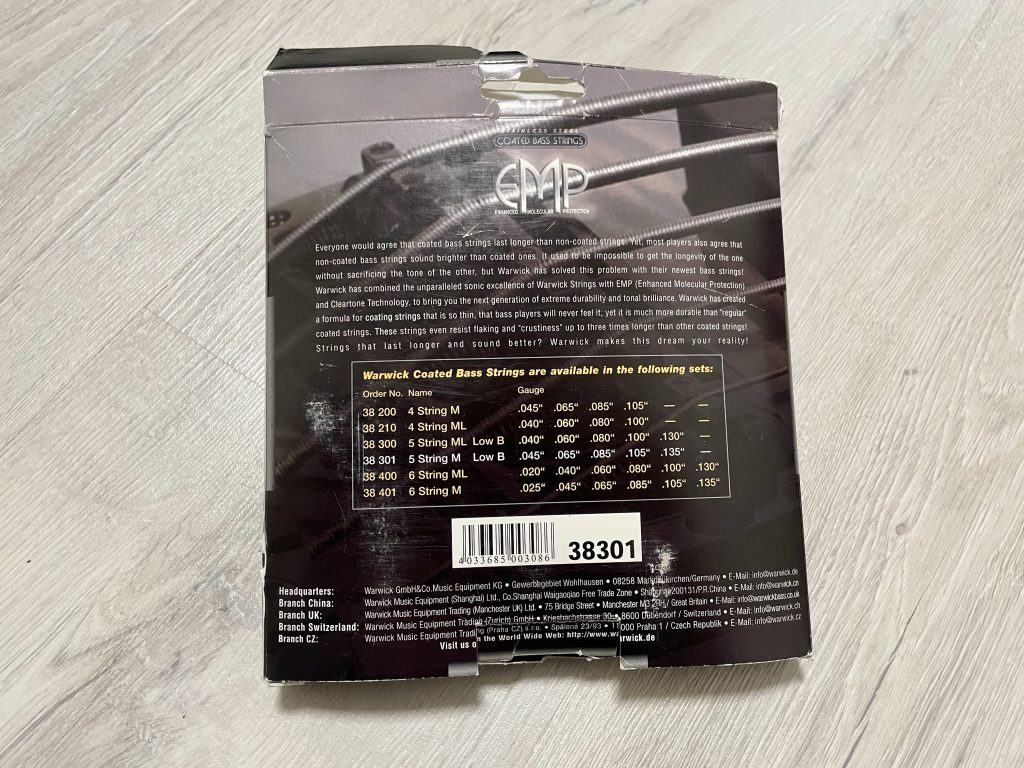
Thin strings ring sharply. Especially when playing slap. The sound is more piano. They build well, sit well in the bridge. They are not restored with alcohol, but they ring for a long time after the first installation, longer than Hi Beams. These are coated strings, but in no way can it be seen and distinguished from uncoated strings.
These sets occupy slightly different niches in terms of sound, the first two are necessary, sometimes the third.
Top 2
Ernie Ball Slinky Cobalt 45 – 130 2736. Very well balanced strings. The sound is even, the signal level is above average, which reduces the presence of noise in the recording. Very harmonic 5th string. They build well, read very well in the mix, maybe even the best bass strings for metal. Very good to get through the mix. They sound lower in general, while having a lot of ringing. No nosal sound.
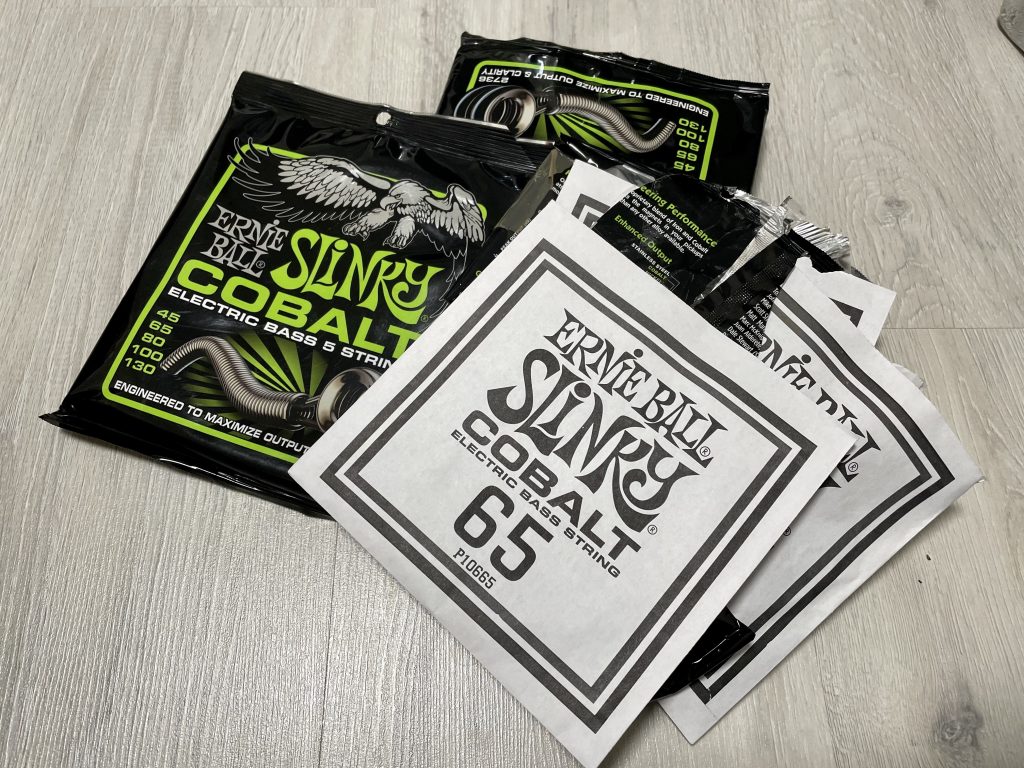
But I don’t really like the character of their sound when played solo or in a song where there is a lot of room for the bass sound. They seem a little boring to me. They are different from other strings. When new, they generally have an overtone like a tin can. These are the only strings that I like not new more than new.
They do not lose their sound for a long time, sometimes they oxidize, but this does not affect the sound. It makes no sense to restore them in alcohol.
I was afraid that they would eat the frets intensely. But so far everything seems to be within the normal range.
In general, I would recommend them to those who play metal. They may or may not lik them very much. Need to try. In a live performance or rehearsal, they can save, they are very well read among the noise and hum.
I love their packaging. There were cases when the strings with their paper envelopes oxidized from a long stay in the basement damp room of the DR store. And at Ernie Ball, everything is hermetically sealed. Perhaps because of the rigidity I play them better. And the sound is balanced. Their sound stands apart from all the other strings. It’s hard to describe their sound comparing with other models and brands.
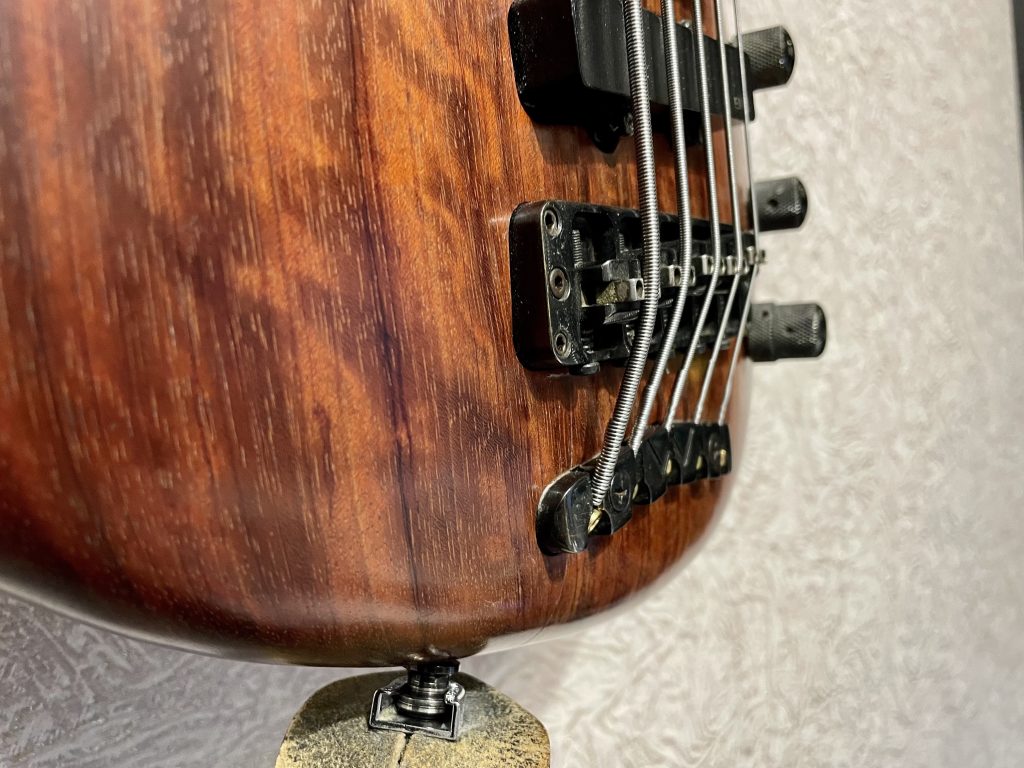
Other strings
DR Strings Lo-Riders have slightly more ringing, less midrange and more low end than the Hi Beams. I had problems with the 5th, it didn’t fit in the bridge. I barely put it in there, scratched the bass, so I don’t use it. Otherwise the strings sound good. If you want more clang and choosing from DR, I would recommend this set.
DR Strings Fat-Beams 45 – 125. Comfortable to play. The strings are softer than D’Addario. The Fat-Beams have more zing than the Hi-Beams, they sound lower overall and have less bottom end. Thick strings growl, there is a beautiful growl. But I didn’t like them in a lowered tuning, they were too dim. But in the standard or drop D – everything is fine. The character of the sound is similar to Blast – Marcus Miller – Estival Jazz Lugano, Switzerland July 4, 2008. Not even on Fender, but on my Warwick, this sound is obtained.
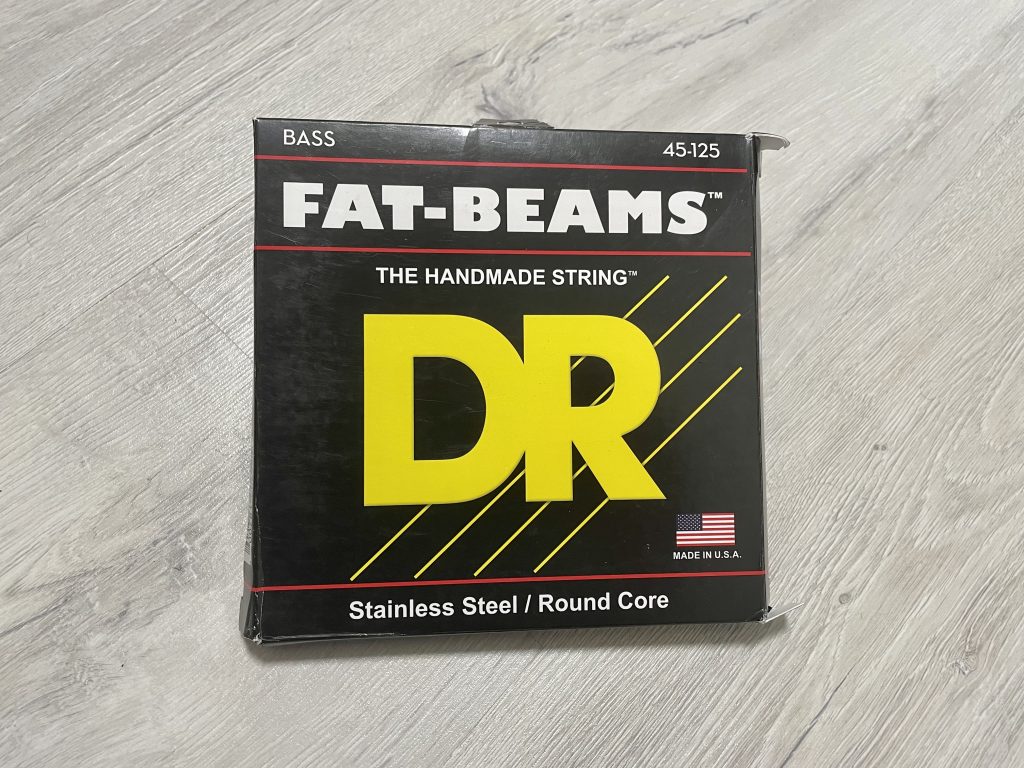
Warwick Black Label – 5th tapered. It’s not the same as EMP in terms of sound. Not as bright highs, they sound closer to DR Strings Hi-Beams.
Warwick Red Label 42 301 M 045-135, steel, non-alcohol retardant. More brutal than Dunlop 45-130 med 5-string nickel plated. They didn’t leave any bright impressions.
Dunlop 45-130 med 5-string nickel plated – I hammered the 5th string into the bridge with pliers, because it has too many coils wound on it in that place. A lot of hum in the sound. I usually play two 50/50 pickups, these strings have a nicer sound in the neck only position. Crunchy sound, piano-like in the blind. Different radically from the other strings. Liked for quiet songs, combined with overloaded guitars not so much. For lighter styles of music.
Summary
Hypothetically, with the help of EQ’s, you can wind up any sound. But in practice, ugly additional noises and sounds come out, and sometimes there are no necessary overtones at all, no matter how you turn the settings. Therefore, it is necessary to put strings that are as close as possible to the desired sound. And you need to change strings more often. Especially before recording and concert.
Fresh cheap strings are better than expensive old strings. Therefore, it is worth choosing strings for yourself in such a price range in which you can afford to buy new sets to replace.




